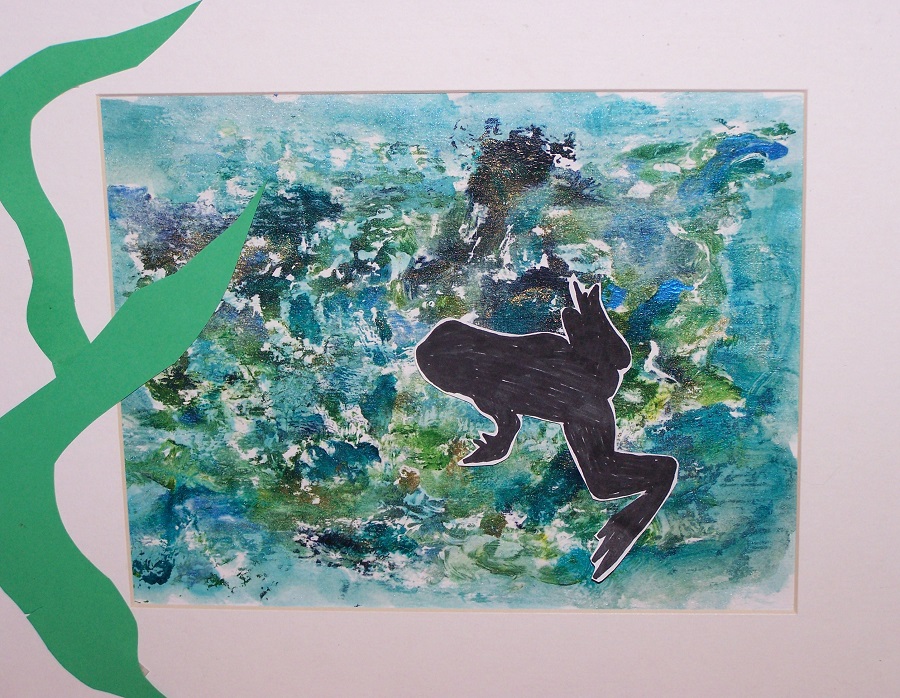Objective: To enhance descriptive writing and action using illustrations cut into parts
Age: 5+ Time: 40 minutes (writing varies) Grades: K-4
Materials:
- Pictures of animals, people, places (optional)
- Colored pencils
- Markers
- Crayons or paint
- White paper
- Construction paper
- Lined paper
- Pencil
- Glue
- Scissors (see other ways to use this lesson)
Visual Illustrations
Visual Illustrations can present an entire picture in parts. Imagine being able to teach and enhance action (verbs), adjectives, nouns, story or topic settings, characters, descriptive writing, poetry, non-fiction and narrative writing all with one visual illustration. Just step back and view the whole picture. Look closely and see the parts.

Dolphins Gracefully soaring through the sunlit sky reminding me of what freedom means.
-by Molly, age 9
Lesson: Basic Visual Illustration
1) Draw a scene (predetermined topic and character) on a piece of 8 ½ x 11 inch of white paper. Use details and color or paint the entire page. If time restraints occur, allow children to use magazine pictures, cards, photographs or coloring pages instead.
2) Fold the picture into thirds or fourths (ruler optional). Cut along each fold or traced line, separating the picture into parts.
3) Glue pieces onto larger colored construction paper, leaving space between the pieces. Step back and you will see the entire scene.
4) For example, encourage the children to write their poem or expository paragraph on lined paper (typing optional), cut, glue and attach to the bottom of the visual illustration or to the side of the picture. Perhaps the children studied dolphins like Molly. Encourage the children to emphasize the topic, along with the scenery, so as to show action. The more details used, the more there is to write about; especially when children rely on previous knowledge.
5) Edit work and bring to a final composition. Embellish the visual illustration creatively, share aloud and display for others to admire.
Evaluation:
Move throughout the room to monitor, assess and confer when needed in order for incidental learning to occur. Depending on the skill you are reinforcing, this activity lends itself easily to assessing descriptive sentences, elaborative sentences (answering: who, what, where, why, when, and how), and use of adjectives, verbs and nouns, poetic, expository and narrative writing. Be sure to inform your students about your expectations. Perhaps you can orally assess a particular skill. Their written application will already be completed. Another way to organize your anecdotal notes can be to create a skill chart and check off the skills that have been mastered or need more improvement. See other ways to use this lesson.
Other Ways to Use This Lesson
Remember to allow the opportunity for your learners to write “visually”. Let them see the picture or parts before they write. Train them early to ‘visualize’ and see the details then they can eventually transfer visual imagery to visual memory. Guaranteed, your students will feel more confident with this approach.
As stated earlier, this lesson can focus on one skill at a time. When you are introducing “verbs” or action words, decide which kind of verb you want them to use. If you are teaching a class topic, have a brainstorm session and list their verbs, nouns, and adjectives. Now, they can use the words to inspire their descriptive writing. Older and more fluent writers may not need any brainstorming at all. The children can use action words to enhance their subject, write a sentence and circle those words in their descriptive sentence. This activity can give you an on-going assessment as well. Similarly, allow each child to write a descriptive sentence telling what the “subject” or “noun” looks like and what it is doing and “where”.
 Remind the children to use the verb to describe the action. Sometimes it is easier to tell them to use doing words: verbs with ‘ing.’ You decide what suffixes to include: ly, es, ed
Remind the children to use the verb to describe the action. Sometimes it is easier to tell them to use doing words: verbs with ‘ing.’ You decide what suffixes to include: ly, es, ed
Note: Try this activity with no scenery and just the subject. If the study or focus is about dolphins, forget the background and just create the dolphin, cut into parts, and inspire the visual writing in a different way. Now the children are only focused on the ‘subject’.
Additionally, you can use this activity every week for practice along with reinforcing various topics throughout the year. For instance, you may be reading about birds one week. So, allow the children to do a similar activity using pictures of birds. If you have stickers, try them to save time. Just illustrate the background. If time is a challenge, keep pictures of animals, people, and places available, with or without a background for your students to use rather than spending time illustrating. If you have time to illustrate, try stencils to trace and add details as needed. Just cut the visual into parts, glue to a background and be creative. Write a poem, descriptive or expository paragraph. Remember, this is a strategy. It is a fun and easy way to excite children throughout the writing process. Encourage the children to explore variations on their own. Share their work and display their creative results as the year progresses.
About the Author:
 Kim Waltmire is a state and national award-winning educator. She holds an honorary seat with the 2006 USA Today All-Star Teacher team. Kim is a graduate from CCSU with a Masters in Early Childhood Education. She published a writing & literacy book; Picturesque Writing, now self-published as The Art of Visual Writing for elementary teachers K-5. Kim also published a Read-Along Series for primary grades, coupled with spelling, grammar, science and social studies lessons for k-12 with a home-school company. Her writing and Project Based Learning strategies were recognized and published in the Creative Classroom Teacher’s magazine; May/June 1998 issue. She was recognized for her educational contributions and Project Based Learning by Oprah Winfrey, interviewed on CNN, Fox News, and honored by the CT State Governor several times. Kim has taught elementary school for 28 years and presently an Educational Literacy Consultant. Kim’s passion is teaching writing literacy for all learning styles.
Kim Waltmire is a state and national award-winning educator. She holds an honorary seat with the 2006 USA Today All-Star Teacher team. Kim is a graduate from CCSU with a Masters in Early Childhood Education. She published a writing & literacy book; Picturesque Writing, now self-published as The Art of Visual Writing for elementary teachers K-5. Kim also published a Read-Along Series for primary grades, coupled with spelling, grammar, science and social studies lessons for k-12 with a home-school company. Her writing and Project Based Learning strategies were recognized and published in the Creative Classroom Teacher’s magazine; May/June 1998 issue. She was recognized for her educational contributions and Project Based Learning by Oprah Winfrey, interviewed on CNN, Fox News, and honored by the CT State Governor several times. Kim has taught elementary school for 28 years and presently an Educational Literacy Consultant. Kim’s passion is teaching writing literacy for all learning styles.
- Twitter: @kwaltmire
- LinkedIn: www.linkedin.com/in/kimwaltmire/
- Website: www.visualccl.com







